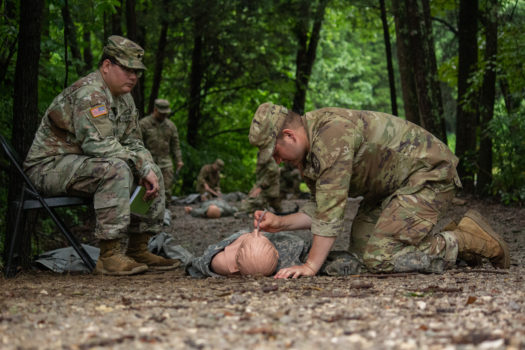Tactical Combat Casualty Care (TCCC) at Cadet Summer Training is not a timed event but remains a test for Cadets if they can quickly respond to care under fire.
Cadets are assessed on knowing the different steps of evaluating a casualty and how to utilize the different items in an individual first aid kit (IFAK) during the TCCC lane.
Ssg. Mark Bartruff, a lane NCOIC for TCCC helped to ensure Cadets know how important medical care is to learn as a future army leader.

“Not everybody has a medical background,” said Bartruff. “But we give them just some of the basics so they have an understanding of some of the medical stuff.”
Medical equipment that they learn to use can be found in a standard IFAK include tourniquets, nasopharyngeal airways (NPA), and field dressing. Cadet Daegan Lutz, Grand Canyon University, had to insert a NPA into his practice casualty’s nose in order to clear the airway.
“If they are unconscious, you usually put that in there to maintain that patency of the airway so they can continue to breathe while unconscious,” said Lutz.
The TCCC lane was not his first time being evaluated through a medical standpoint, as Lutz is a recent nursing graduate and is preparing to take the National Council Licensure Examination (NCLEX) as his final step to become a nurse.
Having a family that served over 40 years in the medical field, Lutz continued the family tradition and hopes to branch into the Nurse Corps.

“I have met some really great nurses and they told me great stories,” said Lutz. “nurses are the ones who are with the patients the most – they build that relationship and trust.”
Lutz experienced a patient during his time as a nurse that was experiencing a stroke, and because of his quick action to call for help, he prevented the conditions from getting worse. While not all nurses will be out providing care initially to casualties, it remains crucial that every Cadet learns to react quickly and notice any changes to their soldiers.
“If they see something – they can stop and help,” said Lutz. “It is pretty important to notice your soldiers and if there’s a change, it’s always important to reassess.”




